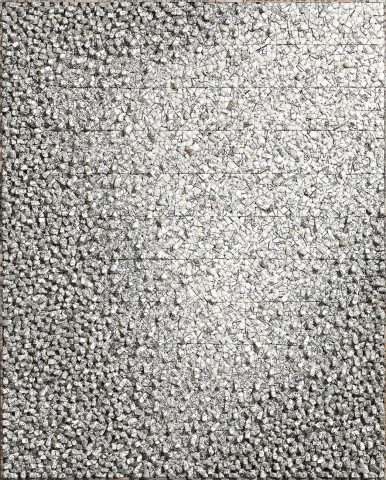AGGREGATION 03 – S139A, 2003
Chun Kwang Young
Korean mulberry paper, polystyrene foam and string on board
101.0 x 81.0 cm
signed, dated and inscribed with title in Hanja and English verso: Chun, Kwang-Young / AGGREGATION 03 – S139A / … / – 03 KY Chun
Conny Dietzschold Gallery, Sydney
Private collection, Melbourne
Chun, Kwang-Young Recent Works, Conny Dietzschold Gallery, Sydney, 5 September – 18 November 2003
Creating an impression of flooding light through his dextrous manipulation of three-dimensional forms and the relative density of the printed text of their wrapping, Aggregation 03-S139A, 2003 is a masterful example of Chun’s signature artworks. Revered as one of Korea’s most important contemporary artists, Chun’s reputation has been built upon a single fertile idea sustained over twenty years of continued practice – a unique means of conveying elements of the human condition in a formally abstract syntax, infused with a profound respect for his own cultural heritage.
Chun uses thousands of triangular polystyrene prisms each wrapped in Korean mulberry paper, arranging them into vast and complex configurations. The prisms become the atoms that form Chun’s sculptural and topographical reliefs, each titled Aggregation. By highlighting the subtle differences between size, tone and density of the blocks, Chun can create effects of light, texture and even movement – effects which are most apparent when the work is viewed from a distance.
For Chun, each unique carved and wrapped prism is representative of a unit of information, that, when collated (or aggregated) en masse, can be used as a metaphor for human collaboration and conflict. When viewed holistically, the prisms move as one in vast tides against one another and in opposition to the outside world. Chun spent many years in the U.S. training as an Abstract Expressionist painter, and used this understanding of gesture and dynamic composition to create these works bristling with energy, at times even exploding out of the confines of their bas relief and spherical forms. Looking to the wrapped frame of this work, it is evident that even the ‘all-over’ theory of abstract expressionism found its way into Chun’s Aggregations.
Reaching far beyond their formal qualities, the power of Chun’s Aggregations is inseparable from their cultural significance. In many interviews given throughout his career, Chun has told the foundation story of his practice – where he channelled his frustration and disappointment with American consumerism into the realisation of his own culturally authentic mode of expression. This oft-told story is based on a childhood memory of visiting a Chinese herbalist, who had hanging from the ceiling of his pharmacy a myriad of packaged herbs each wrapped in mulberry paper and emblazoned with wishes of good health in Chinese script. It was the memory of these packages which inspired the creation of Chun’s triangular prisms.
The hanji paper that Chun uses, created from the inner bark of the mulberry tree, is renowned in Asia for its durability and versatility. One cannot underestimate its ubiquity in Korean culture. It was indispensable for the printing of academic and artistic texts, and was even used, when laminated with rice starch, for food preservation and as an architectural building material. For Chun, the significance of this material in his artwork was threefold: it heralded a return to traditional artisanal methods of creation, it linked his art to his own personal cultural heritage, and nostalgically connected his artworks to the wealth of human experience that had preceded him. The hanji paper used in Chun’s Aggregations is second-hand, torn from the pages of old Korean and Chinese publications hoarded by the artist. It has become, for the artist, an extension of the lives of the hundreds of people who have come into contact with these sheets: ’For me, old paper has a life, a history ... In a way, I’m wrapping the stories of people’s lives’.1
1. The artist quoted in Kloesnikov-Jessop, S., ‘Korean Artist Turns Old Mulberry Paper Into Modern Art’, The New York Times, New York, 14 August 2006, accessed online 16 March 2018 (http://www.nytimes.com/2006/08/14/arts/design/14chun.html)
LUCIE REEVES-SMITH
